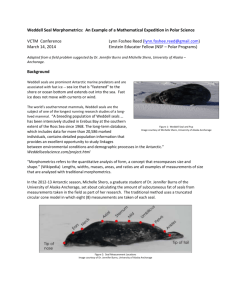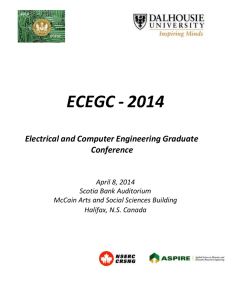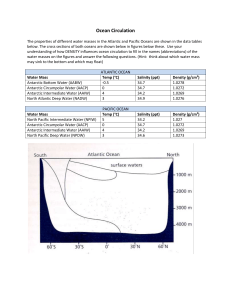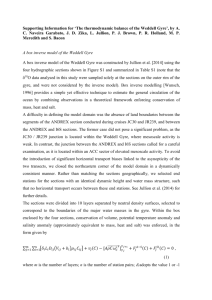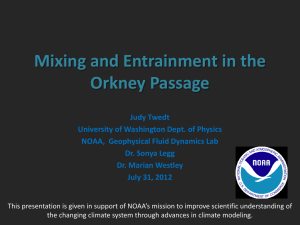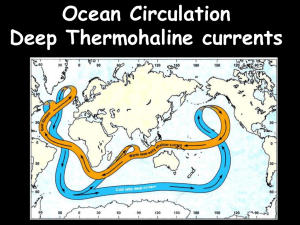- NERC Open Research Archive
advertisement
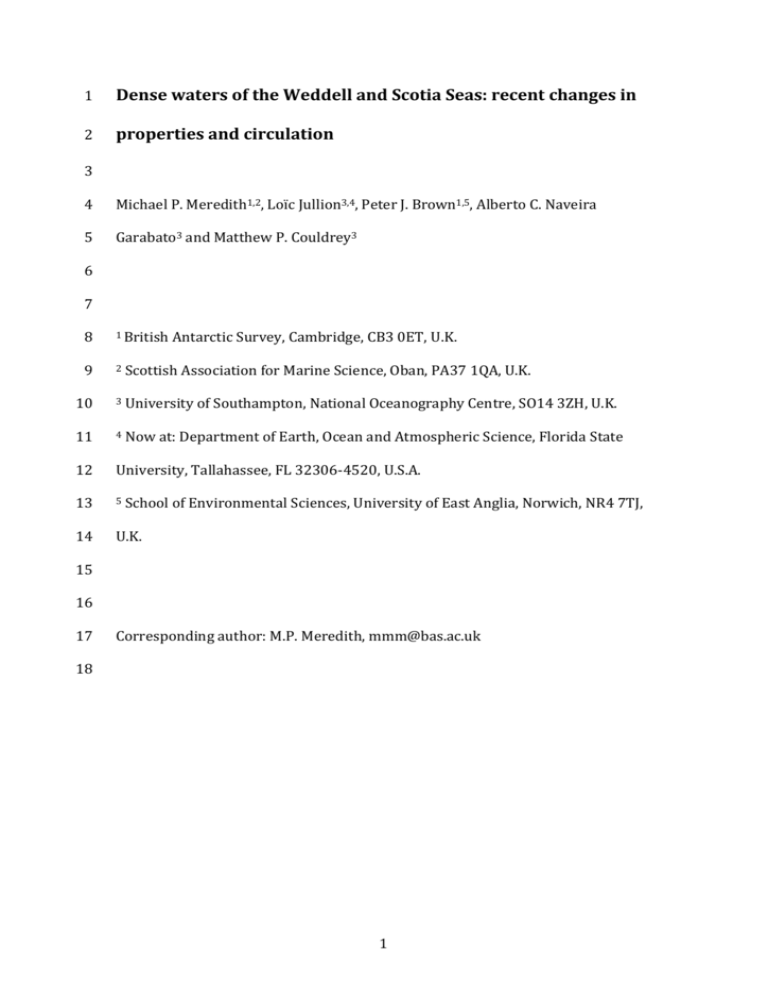
1 Dense waters of the Weddell and Scotia Seas: recent changes in 2 properties and circulation 3 4 Michael P. Meredith1,2, Loïc Jullion3,4, Peter J. Brown1,5, Alberto C. Naveira 5 Garabato3 and Matthew P. Couldrey3 6 7 8 1 British Antarctic Survey, Cambridge, CB3 0ET, U.K. 9 2 Scottish Association for Marine Science, Oban, PA37 1QA, U.K. 10 3 University of Southampton, National Oceanography Centre, SO14 3ZH, U.K. 11 4 Now at: Department of Earth, Ocean and Atmospheric Science, Florida State 12 University, Tallahassee, FL 32306-4520, U.S.A. 13 5 14 U.K. School of Environmental Sciences, University of East Anglia, Norwich, NR4 7TJ, 15 16 17 Corresponding author: M.P. Meredith, mmm@bas.ac.uk 18 1 19 Abstract 20 21 The densest waters in the Atlantic overturning circulation are sourced at the 22 periphery of Antarctica, especially the Weddell Sea, and flow northward via 23 routes that involve crossing the complex bathymetry of the Scotia Arc. Recent 24 observations of significant warming of these waters along much of the length of 25 the Atlantic have highlighted the need to identify and understand the time- 26 varying formation and export processes, and the controls on their properties and 27 flows. Here, we review recent developments in understanding of the processes 28 that control the changing flux of water through the main export route from the 29 Weddell Sea into the Scotia Sea, and the transformations of the waters within the 30 Scotia Sea and environs. We also present a synopsis of recent findings that relate 31 to the climatic change of dense water properties within the Weddell Sea itself, in 32 the context of known Atlantic-scale changes. Amongst the most significant 33 findings are the discovery that the warming of waters exported from the Weddell 34 Sea has been accompanied by a significant freshening, and that the episodic 35 nature of the overflow into the Scotia Sea is markedly wind-controlled and can 36 lead to significantly enhanced abyssal stratification. Key areas for focusing future 37 research effort are outlined. 38 39 40 Keywords: Antarctic Bottom Water; dense water export; overturning circulation; 41 abyssal mixing. 42 43 2 44 Introduction. 45 46 The dense waters that form around the periphery of Antarctica are key 47 components of the global ocean circulation (1). They are produced via intense 48 air-sea-ice interaction over the continental shelf regions, including exchanges 49 with the Antarctic ice sheet (2, 3), and are subsequently exported northward to 50 cool and ventilate much of the global ocean abyss (4, 5). Often collectively 51 termed Antarctic Bottom Water (AABW), the flow of these waters constitutes 52 much of the lower limb of the three-dimensional global ocean circulation. AABW 53 can represent a large reservoir for heat and other tracers such as carbon dioxide, 54 the changing volumes of which can be significant for modulating planetary 55 climate (6, 7). 56 57 Over the past several decades, perceptions have changed concerning where the 58 dominant sources of AABW are located, however the Weddell Sea (Figure 1) is 59 still considered to be volumetrically the most significant, and has a particular 60 relevance to Atlantic climate because of its role in renewing the densest layers of 61 the Atlantic Meridional Overturning Circulation (AMOC) (8-10). The broad 62 shelves to the southwest and west of the Weddell Sea are key regions for dense 63 water production, because brine-enriched waters can pool here for a number of 64 seasons before descending into the deep ocean as part of the AABW mixture (2, 65 9, 11). Similarly, the Filchner-Ronne and Larsen ice shelves that fringe the 66 southwestern and western Weddell Sea respectively offer potential for the 67 cooling of dense shelf waters below the surface freezing point, hence 68 preconditioning the waters prior to their inclusion in AABW (11-13). In addition 3 69 to these sources located within the Weddell Sea, it has been demonstrated that a 70 significant flow of AABW enters the basin from the east (14), and it was recently 71 shown that this component of AABW forms predominantly near Cape Darnley 72 due to the very intense sea ice production there, without the requirement for an 73 ice shelf or a broad continental shelf region (8). There has been a suggestion of 74 significant intermixing of AABW varieties from their different source regions as 75 they penetrate the lower latitude basins (15), thus variability in the properties 76 and export of AABW from the Weddell Sea has the potential to influence deep 77 ocean properties around a large sweep of the Southern Hemisphere. 78 79 Within the Weddell Sea, AABW can recirculate within the Weddell Gyre, or, if it is 80 sufficiently light, can escape to the north through gaps in the South Scotia Ridge 81 or by flowing around the South Sandwich Islands at the eastern edge of the 82 Scotia Sea (Figure 1). The route through the Scotia Sea is the most direct, with 83 AABW entering this basin predominantly via Orkney Passage (the deepest cleft 84 in the South Scotia Ridge), and then flowing to the northeast to exit via Georgia 85 Passage immediately to the east of South Georgia (16, 17). A further branch of 86 AABW also flows westward as a boundary current toward Drake Passage (Figure 87 1) (16). 88 89 One of the most marked changes in ocean climate in recent decades has been the 90 warming of the deep ocean throughout much of the globe, with implications for 91 sea level and the planetary-scale heat budget (18). This warming has been 92 especially marked in the southwest Atlantic (19, 20), i.e. the region where deep 93 waters are renewed predominantly from the Weddell Sea via the Scotia Sea, 4 94 though this branch of warming has extended also into the North Atlantic at least 95 as far as 24N (21). The causes of this warming are not yet well established, and 96 attribution is challenging due to the possibility of planetary wave signals being 97 superposed on the advective ones (c.f. 22), and the complications introduced by 98 aliasing of temporally sparse hydrographic section (23). However, it has been 99 hypothesized to be due to a reduction in the export of AABW and an associated 100 slow down of the lower cell of the AMOC (21), and, if verified, this would have 101 significant implications for the long-term stability of climate and deep-ocean 102 ventilation. This highlights the need to understand better the drivers and 103 controls on AABW properties, circulation and changes. 104 105 Changes in properties of Weddell Sea AABW: recent findings 106 107 Motivated by the large-scale warming of AABW and reports of its reducing flux 108 along much of the length of the Atlantic (21), an obvious starting point is to 109 examine changes of the dense waters within the Weddell Sea itself. The most 110 comprehensive information relating to gyre-wide changes derives from the 111 sustained programme of repeat hydrographic measurements on the Greenwich 112 Meridian (24). This has indicated a relatively invariant potential temperature for 113 Weddell Sea Deep Water (WSDW, the component of AABW in the Weddell Sea 114 that is light enough to be exported from the region) during 1985 to 2000, 115 followed by a rapid rise in temperature thereafter (Figure 2). For the denser 116 component of AABW in the Weddell Sea (Weddell Sea Bottom Water; WSBW, 117 which is too dense to leave the Weddell Gyre directly), the changes are better 118 characterized by a drop in temperature during the 1990s compared with the 5 119 time immediately before or after. These changes were ascribed to variations in 120 wind forcing over the Weddell Gyre, whereby changes in the intensity and shape 121 of the gyre circulation could influence the inflow of warm, saline water from the 122 Antarctic Circumpolar Current (ACC) and its reprocessing on and adjacent to the 123 shelves into the cold, dense waters that form AABW (24). However it is not 124 straightforward to relate the timescales of the temperature changes in the 125 Weddell Sea waters with those observed downstream in the Atlantic. For 126 example, at Vema Channel, the most significant throughflow of AABW from the 127 Argentine Basin to the Brazil Basin in the South Atlantic, the bottom water has 128 warmed at a relatively constant rate since the 1970s (20). In this context, it is 129 important to note that the bulk water mass changes within the Weddell Sea do 130 not necessarily reflect well the changes in the boundary current systems that 131 feed the overflow routes for AABW across the South Scotia Ridge, and that 132 ultimately supply AABW to the lower cell of the AMOC in the Atlantic. Indeed, 133 whilst some similarity between the properties of the AABW that recirculates 134 within the Weddell Sea with that which is rapidly exported may be expected on 135 long timescales, it is not the case that a strong correlation need exist between 136 them on all timescales. 137 138 In the northwestern Weddell Sea, the boundary current upstream of the most 139 significant outflow of AABW from the Weddell Sea (Orkney Passage; Figure 1) 140 has been monitored with moorings since the late 1990s (25, 26). From these 141 data, a marked seasonal signal in the WSBW component has been detected (25), 142 with significant interannual variability superposed (26). Both of these have been 143 linked to changing atmospheric circulation, with the latter related to large-scale 6 144 modes of climate variability that can affect both the production of dense shelf 145 water and its export into the deep ocean. Seasonal and longer-period changes in 146 Weddell Sea dense water outflow and transports have been investigated using 147 numerical models, and the role of wind forcing in controlling both the export of 148 dense water from the shelves and the intensity of the gyre circulation on these 149 timescales was highlighted (27, 28). In the presence of significant seasonal and 150 interannual variability, it is clear the existing monitoring efforts need to be 151 sustained in order to determine better the nature and cause of long-period 152 (decadal) changes. 153 154 One branch of AABW that has shown a clear warming signal is the inflow at the 155 eastern edge of the Weddell Gyre (Figure 1). This water is believed to be a 156 significant contributor volumetrically to the AABW found in the Weddell Sea, 157 having formed further east (in the vicinity of Cape Darnley) and spread 158 westward along the continental margin to penetrate into the Weddell Gyre (8, 159 29). Based on repeat occupations of the World Ocean Circulation Experiment 160 (WOCE) I6S line at around 30E, a distinct warming of this AABW since the early 161 1990s was demonstrated (30). Using transient tracer (chlorofluorocarbon) and 162 other data, it was argued that this is due to a greater entrainment of warm, mid- 163 depth waters of the ACC into the plumes of dense water that descend from the 164 shelf in its formation region, ultimately caused by a climatological southward 165 shift of the southern edge of the ACC (8, 30). The expected salinification that 166 would accompany the warming under this process was not observed, but 167 separately a freshening of much of the AABW to the east of the Weddell Gyre has 7 168 been detected, and it is likely that these factors were (to some extent) mutually 169 compensating (30). 170 171 The negligible salinity change in the inflowing AABW from the east of the 172 Weddell Gyre (30) coincided with relatively small changes in bulk AABW salinity 173 along the Greenwich Meridian, with an increase in WSDW salinity during the 174 1990s and early 2000s reversing after 2005, and a decrease in WSBW salinity in 175 the late 1980s ceasing after the early 1990s (Figure 2) (24). Downstream in the 176 South Atlantic, salinity changes within Vema Channel since the 1970s have been 177 weak (20). Compared with the marked (and in some places, very strong) AABW 178 freshening trends observed elsewhere around Antarctica, these facts could be 179 deemed surprising (31, 32). 180 181 New findings have changed this perspective. Using data from the WOCE SR1b 182 section in eastern Drake Passage (Figure 1), a recent study (33) documented a 183 long-term freshening of AABW since 1993 (Figure 3). Although these data were 184 collected outside the Weddell Sea itself, it is well known that this branch of 185 AABW derives from the WSDW that forms in the northwestern Weddell Sea (in 186 the vicinity of the Larsen ice shelves) and then flows northward and eastward to 187 cross the South Scotia Ridge, after which one limb flows westward toward Drake 188 Passage (Figure 1). Consequently, it was inferred that the AABW freshening 189 observed in Drake Passage was indicative of freshening of WSDW happening at 190 its formation sites in the western Weddell Sea (33). Other processes that might 191 potentially have affected the AABW properties, such as changing mixing as it 192 flows over the rough topography of the South Scotia Ridge or changing bottom 8 193 Ekman layer processes, were discounted as they would have affected the 194 potential temperature-salinity relationship of the water mass in a manner 195 different to that observed (33). 196 197 In terms of attribution, it was not the case that a unique process could 198 unambiguously explain the freshening of AABW in Drake Passage, however 199 observations of a marked freshening of the shelf waters in the northwestern 200 Weddell Sea gave further support to it having its origins there (34). It was 201 suggested that the collapse of the nearby ice shelves (most dramatically, Larsen 202 B), and the acceleration of the glaciers that were buttressed by the ice shelf prior 203 to its collapse, were instrumental in the freshening of the shelf waters and thus 204 the AABW formed there, though smaller contributions from sea ice changes and 205 precipitation could not be excluded (33). Importantly, given that the collapse of 206 Larsen B has been argued to have an anthropogenic cause (specifically an 207 intensification of atmospheric circulation and increase of air temperatures on the 208 eastern side of the Antarctic Peninsula (35)), this is suggestive of an 209 anthropogenic change in abyssal water properties over potentially large scales. 210 Given the putative causes of the salinity decrease, and the potential for its 211 continuation given the current nature of climate change in its formation region 212 (ongoing warming at the Antarctic Peninsula), further freshening of the AABW 213 might be expected, and, if it does occur, it is likely to be progressively traceable 214 along much of the length of the Atlantic. One could speculate that, should further 215 dramatic ice shelf collapses occur at the eastern Peninsula (e.g. of Larsen C; 216 (36)), the freshening of shelf waters and AABW could accelerate. Alternatively 217 (and equally speculatively), if the shelf waters become sufficiently fresh that they 9 218 are too light to convect seasonally to the bottom of the shelf, this mode of AABW 219 renewal may diminish. Predictive skill concerning when or if such changes may 220 happen is currently lacking. 221 222 It should be noted that, contemporaneous with the salinity decrease in the AABW 223 observed in Drake Passage, there was no apparent decrease in the thickness of 224 the AABW layer there (Figure 3). Whilst not conclusive in itself, this nonetheless 225 indicates that the postulated volumetric reduction in AABW export into the 226 lower limb of the Atlantic overturning does not feature strongly in these data 227 (33). 228 229 Given the changes observed in the dense waters originating in the Weddell Sea, 230 and the great reach of the waters so formed, it is incumbent upon us to maintain 231 long-term monitoring efforts to determine and understand the ongoing climatic 232 variations of the waters, and their impacts. However, this is not sufficient by 233 itself, since the waters can be modified en route to lower latitudes, and 234 understanding the controls on this, and how they change with time, is also key. 235 We will next summarise some recent key findings that relate to the modifications 236 of these waters as they transit northwards toward the Atlantic, and place these 237 results in the context of the known large-scale changes in deep ocean climate. 238 239 Controls on the flow and properties of dense water through the Scotia Sea 240 241 In accord with the above, repeat occupations of the WOCE A23 section in the 242 Scotia Sea (Figure 1) have demonstrated the presence of a marked AABW 10 243 warming trend, with significant interannual variability superposed (37). Indeed, 244 the Scotia Sea appears to be the location where the strong interannual changes 245 observed in the Weddell Sea co-exist with the detectable decadal changes that 246 are more readily observed further north in the Atlantic. Given this, and the 247 rugged bathymetry that the AABW must negotiate en route to the Atlantic, the 248 Scotia Sea marks itself as a key region for understanding of controls on 249 circulation and water mass transformations. 250 251 An early assessment of the AABW in the Scotia Sea hypothesized that its 252 interannual-to-decadal changes in temperature could be caused by changes in 253 wind forcing over the Weddell Gyre, with a stronger (weaker) gyre being 254 associated with warmer (cooler) classes of AABW being exported across the 255 South Scotia Ridge (38). It was conjectured that this may contribute to the 256 decadal warming trend in the Atlantic, since the trend in wind forcing was of the 257 correct sign to induce a long-period withdrawal of the coldest AABW from the 258 bottom of the sills of the ridge crest. This was investigated further using the data 259 from the SR1b section (Figure 1) and the role of wind forcing in controlling the 260 temperature of the AABW overflow across the South Scotia Ridge was confirmed 261 (39). However, it was demonstrated that the lag between wind forcing and 262 bottom temperature response was just a few months, rather than the years or 263 decades that one might expect for a gyre-wide response to large-scale changes in 264 winds, and it was further shown that the changes in AABW temperature were 265 most sensitive to winds in the vicinity of the South Scotia Ridge itself. 266 11 267 These findings were explored further using deep and bottom temperature data 268 from fixed moorings within the boundary current immediately upstream and 269 downstream of Orkney Passage, and the rapid response of bottom AABW 270 temperature and flow speed through the passage to changes in local winds was 271 affirmed (40). A new concept emerged, in which a wind-forced 272 acceleration/deceleration of the barotropic flow along the South Scotia Ridge 273 would have an associated impact on the direction and/or mixing in the bottom 274 Ekman layer close to Orkney Passage, with a rapid impact on both AABW 275 temperature and flow speed through the passage itself (40). Given the climatic 276 increase in winds in this region over the past several decades, this has the 277 potential to exert a significant long-term climatic change on AABW properties 278 downstream in the Atlantic similar to that observed. However, the properties of 279 the AABW upstream in the Weddell Gyre are known to be variable on a range of 280 timescales (25, 26), and the mechanisms for such changes include wind-forced 281 variability and eddy processes affecting the inflow of dense waters into the deep 282 ocean (27, 28, 41), so decoupling the locally-driven changes in Orkney Passage 283 from those generated more remotely is not straightforward. Overall, it is clear 284 that significant detail is still lacking concerning the exact nature of the key 285 processes inherent in the transfer of AABW through the deep passages of the 286 South Scotia Ridge, and the transformations that it undergoes upstream and 287 during the transit. Such information is critically needed if fuller attribution and 288 predictive skill are to be generated. 289 290 Once having entered the Scotia Sea, there are still considerable topographic 291 obstacles that AABW must negotiate prior to entering the major Atlantic basins 12 292 to the north. In particular, it should be noted that the denser classes of AABW in 293 the Scotia Sea cannot exit the basin unaltered; instead they must mix upwards 294 into lighter classes before outflowing. This fact was exploited in a control volume 295 study (42), where the flux of dense AABW across the South Scotia Ridge was 296 used to determine its basin-wide vertical mixing within the Scotia Sea. A very 297 high rate of mixing was derived (around 39 x 10-4 m2s-1), equating to a very short 298 residence time of this water within the Scotia Sea of around 2-3 years. Whilst this 299 calculation did not inform on the relevant processes per se, the strong bottom- 300 reaching flows of the ACC and the rugged bathymetry were mentioned as 301 credible factors in the generation of enhanced mixing (42). 302 303 New insight into these factors was recently obtained from repeat occupations of 304 the WOCE A23 section in the Scotia Sea (Figure 1). Along these, very strong 305 vertical gradients in abyssal water properties were observed occasionally, 306 caused by water being topographically trapped in trenches of several hundred 307 meters deep (Figure 4) (43). The mechanism proposed to explain the creation of 308 these layers was the episodic overflow of dense water across the South Scotia 309 Ridge, consistent with the episodic nature of the wind-forced variability in the 310 overflow described above. The concept is that, following an anomalously dense 311 water intrusion into the Scotia Sea, this bottom layer flows northward along the 312 seabed and sinks upon encountering one or more of the trenches. Subsequently, 313 less dense water can then flow in a less constrained manner over the upper 314 surfaces of these layers, and, combined with the temporal changes in the 315 properties of the waters that cross the South Scotia Ridge, strong gradients can 316 be generated at the interfaces (43). 13 317 318 Using transient tracer data (chlorofluorocarbons and sulphur hexafluoride), age 319 constraints were placed on one such layer, and it was determined to be at least 320 2-3 years old (i.e. it had resided in the trench for at least this long). Using a 321 simple one-dimensional diffusion model, it was inferred that this layer had been 322 subject to a maximum vertical mixing rate of 1 x 10-4 m2s-1 during that period, 323 and probably significantly less. This raises a striking question: how do we 324 reconcile this apparently unexceptional mixing rate from the central Scotia Sea 325 with the very strong basin-average mixing derived previously (around 39 x 10-4 326 m2s-1) (42)? Possibilities include strong spatial structure in mixing within the 327 basin, such that the locations of unremarkable mixing are compensated by other 328 locations of very much greater mixing, and the high basin-average value is the 329 spatial mean of these. Alternatively, there may by strong temporal variability in 330 mixing, such that mixing is low when the dense bottom layers are present, but 331 higher when they are not, with possible impacts from the formation/destruction 332 processes for the layers. More data are needed to resolve this absolutely, but our 333 current hypothesis is that there is strong spatial structure in deep mixing within 334 the Scotia Sea, and that much of the mixing happens close to the vicinity of 335 Orkney Passage itself, which is characterized by very rugged topography, and 336 where the AABW is forced to negotiate some significant narrow gaps as it flows 337 northwards. Future investigations will seek to better resolve these issues, and 338 more fully resolve the key processes responsible for the transformations of 339 AABW as it crosses the South Scotia Ridge and the Scotia Sea en route to entering 340 the lower limb of the AMOC. 341 14 342 Concluding Remarks 343 344 One of the overarching findings of recent work on AABW in the Atlantic sector of 345 the Southern Ocean is that it is far from straightforward to ascribe changes in the 346 low-latitude Atlantic to changes occurring at the formation sites in the Weddell 347 Sea. In some cases, this can be done, such as with the recently-observed 348 freshening of this water mass, but in many cases the temporal patterns of the 349 oceanic climate change do not allow easy attribution. This highlights the need to 350 understand both the processes that dictate the changing properties of the water 351 mass as it forms, and those that control its time-varying export and modification 352 as it transits through the complex bathymetric systems en route to the major 353 Atlantic basins. Increasingly it is being seen that the large-scale properties of the 354 deep and abyssal waters along much of the length of the Atlantic are heavily 355 influenced by small-scale processes that relate to how the water negotiates 356 rugged topography, and by the episodic nature of the flow generated by 357 fluctuating winds. 358 359 In this context, much attention has focused recently on gaps in the South Scotia 360 Ridge, and in particular on Orkney Passage, which is now seen not just as a major 361 throughflow site for AABW, but also potentially a critical location where this 362 water mass is transformed, and where such transformations may change 363 climatically into the future. Inevitably, passages such as Orkney Passage are 364 poorly resolved in coupled climate models and even in state-of-the-art forced 365 ocean models, and the processes hypothesized to be responsible for the 366 transformations are misrepresented or absent. Dedicated model-based studies of 15 367 dense water flow through narrow gaps and passages are making progress with 368 this, but it seems that we are still some way from including the relevant 369 processes in large-scale numerical integrations that can be run for long periods 370 (decades and longer), and this remains a major restriction on our ability to 371 construct projections of future changes. Nonetheless, increasing our predictive 372 skill as it relates to the properties of the large-scale abyssal ocean is increasingly 373 seen as important, because of the role such waters play in determining sea level, 374 global climate and benthic biodiversity. Accordingly, it is incumbent on us to 375 fully determine the key processes, and develop ways of representing their effects 376 in coarse resolution models. A critical first step is targeted fieldwork, 377 complemented by high-resolution, process-oriented modelling. In tandem, 378 strategies should be put in place for the sustained monitoring of key locations, so 379 that the performance of the models that will be generated can be challenged and 380 progressively improved. It should be noted that the process studies needed to 381 understand the mechanisms underpinning long-period variability and change 382 inevitably require multi-year datasets, as single-mission research expeditions 383 are by themselves ineffective at identifying cause and effect relationships. 384 385 The ocean beneath the ice-covered seas remains the most challenging 386 environment in the world from which to make sustained, high-quality scientific 387 measurements, and the Weddell Sea contains some of the least-explored regions 388 on the planet. Combined with the critical need to understand the evolving marine 389 climate of this region, this results in such data as are collected being 390 disproportionately valuable, and the sustained time series especially so. Long- 391 term maintenance of these series at a time that is financially challenging for 16 392 many nations will not be easy, yet scientifically their loss would be ruinous. 393 Greater implementation of marine robotics and the advent of truly autonomous 394 ocean observing will help in future years (44), however the series must be 395 maintained in the meantime using proven approaches. 396 397 398 399 400 Acknowledgements 401 402 The authors are grateful to all the support staff and scientists who have collected 403 the data and produced the insights that are reviewed here. Foremost amongst 404 these was Eberhard Fahrbach, an inspirational colleague and friend. We also 405 thank two reviewers who comments helped improve the original manuscript. 406 407 17 408 References 409 410 1. Lumpkin R, Speer K. Global ocean meridional overturning. Journal of 411 Physical Oceanography. 2007;37:2550-62. 412 2. 413 Deep-Sea Research. 1973;20:111-40. 414 3. 415 formation in the southern Weddell Sea. Deep-Sea Research. 1976;23:301-17. 416 4. 417 water volumes. J Geophys Res. 2008;113(C5). 418 5. 419 abyssal ocean. Geophysical Research Letters. 2001;28(15):2923-6. 420 6. 421 upwelling in glacial-interglacial atmospheric CO2 change. Tellus. 2006;58B:73- 422 87. 423 7. 424 during the last deglaciation. Science. 2012;335(6068):557-61. 425 8. 426 al. Antarctic Bottom Water production by intense sea-ice formation in the Cape 427 Darnley polynya. Nature Geoscience. 2013;6:235-40. 428 9. 429 circulation. Antarctic Science. 2004;16(4):427-37. 430 10. 431 G.Sielder, Church J, Gould J, editors. Ocean Circulation and Climate: Academic 432 Press; 2001. p. 271-302. Gill AE. Circulation and bottom water production in the Weddell Sea. Foster TD, Carmack EC. Frontal zone mixing and Antarctic Bottom Water Johnson G. Quantifying Antarctic bottom water and North Atlantic deep Orsi AH, Jacobs SS, Gordon AL, Visbeck M. Cooling and ventilating the Watson AJ, Naveira-Garabato AC. The role of Southern Ocean mixing and Burke A, Robinson LF. The Southern Ocean's role in carbon exchange Ohshima KI, Fukamachi Y, Williams GD, Nihashi S, Roquet F, Kitade Y, et Jacobs SS. Bottom water production and its links with the thermohaline Rintoul SR, Hughes C, Olbers D. The Antarctic Circumpolar System. In: 18 433 11. Whitworth T, Orsi AH, Kim SJ, Nowlin WD, Locarnini RA. Water masses 434 and mixing near the Antarctic Slope Front. In: Weiss SSJaRF, editor. Ocean, Ice 435 and Atmosphere: Interactions at the Antarctic Continental Margin. Antarctic 436 Research Series. 75. Washington D.C.: American Geophysical Union; 1998. p. 1- 437 27. 438 12. 439 Deep-Sea Research. 1979;26A:1093-120. 440 13. 441 ocean processes over the continental shelf of the southern Weddell Sea, 442 Antarctica: a review. Reviews of Geophysics. 2009;47(RG3003). 443 14. 444 King BA. On the sources of Weddell Gyre Antarctic Bottom Water. Journal of 445 Geophysical Research. 2000;105(C1):1093-104. 446 15. 447 Abyssal connections of Antarctic Bottom Water in a Southern Ocean State 448 Estimate. Geophysical Research Letters. 2013;40(10):2177-82. 449 16. 450 pathways of Southern Ocean Deep Waters in the Scotia Sea. Deep-Sea Research I. 451 2002;49:681-705. 452 17. 453 On the export of Antarctic Bottom Water from the Weddell Sea. Deep-Sea 454 Research II. 2002;49:4715-42. 455 18. 456 Ocean Waters between the 1990s and 2000s: Contributions to Global Heat and 457 Sea Level Rise Budgets. J Climate. 2010 Dec 1;23(23):6336-51. Weiss RF, Ostlund HG, Craig H. Geochemical studies of the Weddell Sea. Nicholls KW, Osterhus S, Makinson K, Gammelsrod T, Fahrbach E. Ice- Meredith MP, R.A. Locarnini, K.A. Van Scoy, A.J. Watson, K.J. Heywood, van Sebille E, Spence P, Mazloff MR, England MH, Rintoul SR, Saenko OA. Naveira-Garabato AC, Heywood KJ, Stevens DP. Modification and Naveira-Garabato AC, McDonagh EL, Stevens DP, Heywood KJ, Sanders RJ. Purkey SG, Johnson GC. Warming of Global Abyssal and Deep Southern 19 458 19. Johnson GC, Doney SC. Recent western South Atlantic bottom water 459 warming. Geophysical Research Letters. 460 2006;33(L14614):10.1029/2006GL026769. 461 20. 462 Water flow through the Vema Channel. Geophysical Research Letters. 463 2007;34(L14607):10.1029/2007GL030340. 464 21. 465 overturning circulation reaches the North Atlantic Ocean. Geophysical Research 466 Letters. 2008;35(L22601):doi:10.1029/2008GL035619. 467 22. 468 Simulated Rapid Warming of Abyssal North Pacific Waters. Science. 469 2010;329(5989):319-22. 470 23. 471 Antarctic Bottom Water at 24.5°N in the Atlantic. J Geophys Res. 472 2011;116(C11026). 473 24. 474 Warming of deep and abyssal water masses along the Greenwich meridian on 475 decadal time scales: The Weddell gyre as a heat buffer. Deep-Sea Research Part 476 II. 2011;58(25-26):2509-23. 477 25. 478 bottom water from the Weddell Sea. Nature Geoscience. 2010;3:551-6. 479 26. 480 interannual variability of Weddell Sea Bottom Water. J Geophys Res. 481 2011;116(C5):C05020. Zenk W, Morozov E. Decadal warming of the coldest Antarctic Bottom Johnson GC, Purkey SG, Toole JM. Reduced Antarctic meridional Masuda S, Awaji T, Sugiura N, Matthews JP, Toyoda T, Kawai Y, et al. Frajka-Williams E, Cunningham SA, Bryden H, King BA. Variability of Fahrbach E, Hoppema M, Rohardt G, Boebel O, Klatt O, Wisotzki A. Gordon AL, Huber B, McKee D, Visbeck M. A seasonal cycle in the export of Mckee DC, Yuan X, Gordon AL, Huber BA, Dong Z. Climate impact on 20 482 27. Wang Q, Danilov S, Fahrbach E, Schröter J, Jung T. On the impact of wind 483 forcing on the seasonal variability of Weddell Sea Bottom Water transport. 484 Geophys Res Lett. 2012;39(6):L06603. 485 28. 486 Water Outflows. Journal of Physical Oceanography. 2011;41:1941-57. 487 29. 488 the sources of Weddell Gyre Antarctic bottom water. Journal of Geophysical 489 Research-Oceans. 1996;105(C1). 490 30. 491 Brown PJ, et al. Remotely induced warming of Antarctic Bottom Water in the 492 eastern Weddell Gyre. Geophysical Research Letters. 2013;40(11):2755-60. 493 31. 494 20th century. Science. 2002;297:386-9. 495 32. 496 Adélie Land Bottom Water near 140°E. Geophysical Research Letters. 497 2005;32(L23601):10.1029/2005GL024246. 498 33. 499 BA. Decadal freshening of the Antarctic Bottom Water exported from the 500 Weddell Sea. Journal of Climate. 2013;26:8111-25. 501 34. 502 northwestern Weddell Sea continental shelf. Ocean Sci. 2011 May 6;7(3):305-16. 503 35. 504 hemisphere annular mode on Antarctic Peninsula summer temperatures. Journal 505 of Climate. 2006;19:5388-404. Kida S. The Impact of Open Oceanic Processes on the Antarctic Bottom Meredith M, Locarnini R, Van Scoy K, Watson A, Heywood K, King B. On Couldrey MP, Jullion L, Garabato ACN, Rye C, Herráiz-Borreguero L, Jacobs SS, Giulivi CF, Mele PA. Freshening of the Ross Sea during the late Aoki S, Rintoul SR, Ushio S, Watanabe S, Bindoff NL. Freshening of the Jullion L, Naveira-Garabato AC, Meredith MP, Holland PR, Courtois P, King Hellmer HH, Huhn O, Gomis D, Timmermann R. On the freshening of the Marshall GJ, Orr A, Lipzig Nv, King J. The impact of a changing southern 21 506 36. Jansen D, Kulessa B, Sammonds PR, Luckman A, King EC, Glasser NF. 507 Present stability of the Larsen C ice shelf, Antarctic Peninsula. Journal of 508 Glaciology. 2010;56(198):593-600. 509 37. 510 Deep and Bottom Waters of the Scotia Sea, Southern Ocean, 1995-2005. Journal 511 of Climate. 2008;21(13):3327-43. 512 38. 513 RJ. Deep and Bottom Waters of the Eastern Scotia Sea: Rapid Changes in 514 Properties and Circulation. Journal of Physical Oceanography. 2001;31(8):2157- 515 68. 516 39. 517 Antarctic Bottom Water from the Weddell Sea. Geophysical Research Letters. 518 2010;37(L09609). 519 40. 520 Jullion L, et al. Synchronous intensification and warming of Antarctic Bottom 521 Water outflow from the Weddell Gyre. Geophysical Research Letters. 522 2011;38(L03603). 523 41. 524 Eddy overturning of the Antarctic Slope Front controls glacial melting in the 525 Eastern Weddell Sea. Journal of Geophysical Research. 2011;116(C11014). 526 42. 527 abyssal Southern Ocean. Nature. 2002;415:1011-4. 528 43. 529 Messias MJ. Dense bottom layers in the Scotia Sea, Southern Ocean: creation, 530 lifespan and destruction. Geophysical Research Letters. 2013;40(5):933-6. Meredith MP, Garabato ACN, Gordon AL, Johnson GC. Evolution of the Meredith MP, A.C. Naveira Garabato, D.P. Stevens, K.J. Heywood, Sanders Jullion L, Jones SC, Garabato ACN, Meredith MP. Wind-controlled export of Meredith MP, Gordon AL, Garabato ACN, Abrahamsen EP, Huber BA, Nost OA, Biuw M, Tverberg V, Lydersen C, Hattermann T, Zhou Q, et al. Heywood KJ, Naveira-Garabato AC, Stevens DP. High mixing rates in the Meredith MP, Brown PJ, Naveira-Garabato AC, Jullion L, Venables HJ, 22 531 44. Meredith MP, Schofield O, Newman L, Urban E, Sparrow MD. The Vision 532 for a Southern Ocean Observing System. Current Opinion in Environmental 533 Sustainability. 2013;5(3-4):306-13. 534 535 536 23 537 Figure Captions. an c South Atl GP A23 OP Weddell Sea I6S 538 539 Figure 1. Schematic of dense water circulation within the Weddell Gyre (red), 540 with primary export routes into and around the Scotia Sea, and into the Southern 541 Indian Ocean. Dense water injection into the gyre occurs at the periphery of the 542 southwestern and western Weddell Sea (blue arrows), and there is inflow of 543 deep waters from the east (purple arrow). Green lines denote locations of repeat 544 hydrographic sections referred to in the text, using their original World Ocean 545 Circulation Experiment (WOCE) identifiers. Orkney Passage (OP) and Georgia 546 Passage (GP) are marked. 547 548 24 549 550 Figure 2. Mean potential temperature (left column) and salinity (right column) 551 for WSDW (upper row) and WSBW (lower row) along the Greenwich Meridian in 552 the Weddell Sea. The dashed lines represent the property averages for 1984- 553 1993, 1994-2002, and 2003-2008. After (24). 554 25 555 556 557 558 Figure 3. Time series of AABW salinity and layer thickness in the eastern Drake 559 Passage (the WOCE SR1b section; Figure 1), downstream of the overflow across 560 the South Scotia Ridge. Note the marked freshening, and the lack of a long-term 561 trend in thickness. (Reproduced from (33)). 562 26 563 564 Figure 4. Potential temperature and neutral density profiles collected from the 565 northern part of the WOCE A23 repeat section in the Scotia Sea (north of the 566 northernmost dogleg in Figure 1). Profiles are colour-coded by year. Note in 567 particular the very steep gradients in temperature and density close to the 568 seabed in some years; this is water that is topographically trapped within deep 569 trenches in the basin, and which can reside there for upwards of 2-3 years. 570 (Reproduced from (43)). 27


